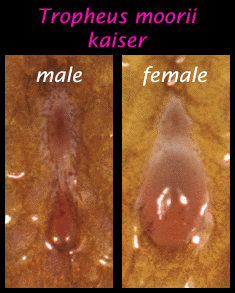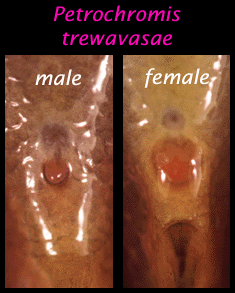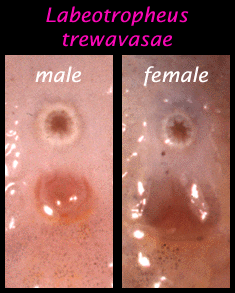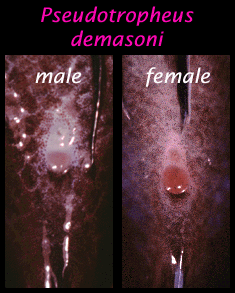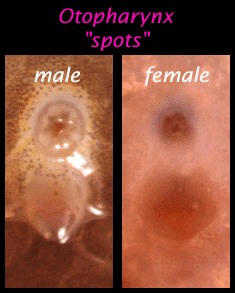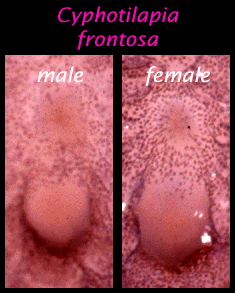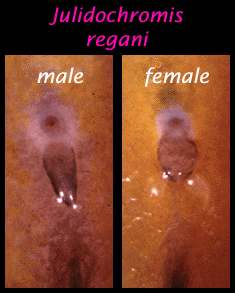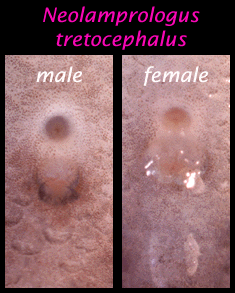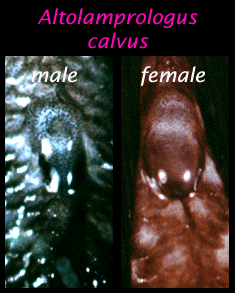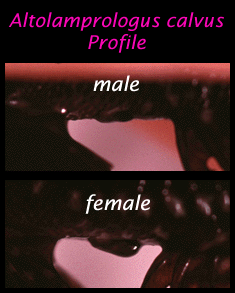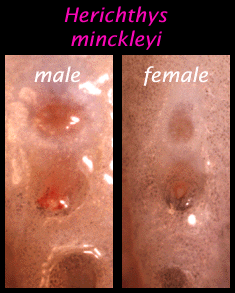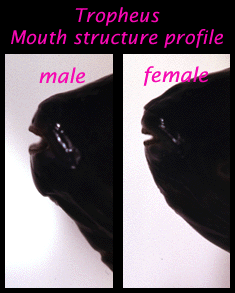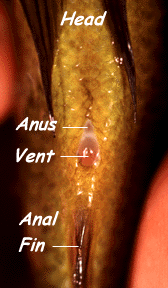 One of the questions I am most commonly asked is how to determine the
sex of fish. The only positive way to determine the sex of sexually
monomorphic species (males and females look similar) is by examination of
the vent. This practice is commonly referred to as venting. What is the
vent and where is it? The vent is the opening between the anus and the anal
fin where the fish will excrete either eggs or sperm. The vent is also
referred to as the genital papilla. For females the term ovipositor
(egg tube) also refers to the vent. The photo on the left shows you where
to look. In this article most of the photos are taken with the fish oriented
with the head of the fish pointing away from you and and turned upside down.
In addition all specimens photographed were sexually mature adults. With
experience you will be able to determine the sex of some species as early
as three to four months of age with a high degree of accuracy.
One of the questions I am most commonly asked is how to determine the
sex of fish. The only positive way to determine the sex of sexually
monomorphic species (males and females look similar) is by examination of
the vent. This practice is commonly referred to as venting. What is the
vent and where is it? The vent is the opening between the anus and the anal
fin where the fish will excrete either eggs or sperm. The vent is also
referred to as the genital papilla. For females the term ovipositor
(egg tube) also refers to the vent. The photo on the left shows you where
to look. In this article most of the photos are taken with the fish oriented
with the head of the fish pointing away from you and and turned upside down.
In addition all specimens photographed were sexually mature adults. With
experience you will be able to determine the sex of some species as early
as three to four months of age with a high degree of accuracy.
The first six species pictured below are of mouthbrooding cichlids. Female mouthbrooders will lay an egg which is much larger in diameter than their substrate egg laying counterparts. Therefore the diameter of the vent is also much larger and easier to distinguish. Just look at the photos of the Tropheus moorii and Petrochromis trewavasae to see how easy these species are to sex. Conversely some substrate egg layers can be a bit more difficult to distinguish. Neolamprologus tretocephalus for example does not have near the differences in vent size and will require a little more experience to determine males from females. In some cases there will also be a pigment difference between the male and female vent. Julidochromis regani is an example of a species in which the male will have an elongated tapered papilla. In these species you can move your finger across the vent from left to right and the papilla will also move. In the photo below of J. regani I moved my finger from left to right. As you can see the papilla is pointing in the direction in which I moved my finger. The last photo below is a profile picture of the mouth of Tropheus moorii. I have included it in this article because it is an extra tool in determining male from female. As you will notice the upper and lower lips of the adult male Tropheus tend to be much thicker and more pronounced than the female. Tropheus can be easily sexed by examining the vent but this will help you predetermine the sex as soon as you pick the fish up. This thickening of the lips is much more pronounced in older adults than in young adults. |

 The tools I find essential in the venting process are a jewelers loupe, an
Optivisor and a good light source. The jewelers loupe should have at least a
20mm lens. An Optivisor is the brand name for a head mounted magnifying
lens. Both of these items can be purchased at a jewelry supply store. In
addition I would recommend four buckets. Why four buckets? In the first
bucket you will place all the fish to be sexed. Place a bucket on the left
and right side of the one with all the fish. As you look at the fish and if
you can make a determination of male or female, put the males in the right
bucket and the females in the left bucket. If you aren't sure what it is,
put it in the fourth bucket. This will prevent you from handling this fish
too many times. You will probably end up going through the undetermined
bucket several times. Why did I put the males in the right bucket? Well,
because males are always right! Just a joke, no hate mail please.
The tools I find essential in the venting process are a jewelers loupe, an
Optivisor and a good light source. The jewelers loupe should have at least a
20mm lens. An Optivisor is the brand name for a head mounted magnifying
lens. Both of these items can be purchased at a jewelry supply store. In
addition I would recommend four buckets. Why four buckets? In the first
bucket you will place all the fish to be sexed. Place a bucket on the left
and right side of the one with all the fish. As you look at the fish and if
you can make a determination of male or female, put the males in the right
bucket and the females in the left bucket. If you aren't sure what it is,
put it in the fourth bucket. This will prevent you from handling this fish
too many times. You will probably end up going through the undetermined
bucket several times. Why did I put the males in the right bucket? Well,
because males are always right! Just a joke, no hate mail please.
While examining the fish do not keep them out of water for more than about 30 seconds. Try to keep the number of times you examine a fish to no more than 3 times. I would recommend that you first try this procedure with hardy Mbuna as opposed to some of the very delicate Tanganyikan species. In addition be sure that when you handle the fish that you have a wet hand. Vent sexing fish is an acquired skill that you will become more proficient at with the more fish you examine. In the beginning you may hardly see the differences in some species, but after some experience they will become much easier to determine. |
|
|
|
|
|
|
|
|
|
|
|
|
|
|
|
|
|
|
